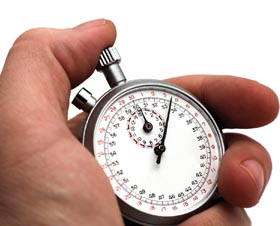The Nano Workout
By
Peter Loescher, DPM
Posted November 1st, 2009

Does the busyness of your life keep you from your desired workout routine? Do you have the time to work out, but suffer from nagging, recurrent, overuse injuries? Are you healthy, but feel like you are stuck in a workout rut, doing the same workout again and again? If you answered yes to any of these, maybe it is time for you to think small.
Among the aerobic set in these parts, century bike rides and four-hour trail runs are commonplace. I recently helped with medical coverage for a 100-mile trail race, in which the winner finished in 16 hours. With these benchmarks out there, you might think that if you don’t have at least an hour to run, bike, ski, or swim, it is not worth changing clothes and getting sweaty. There is compelling evidence to the contrary—that short workouts, even 10 minutes per session—can have significant fitness, health, and emotional benefits. There is also a cumulative effect to the short workouts—three 10-minute workouts in a day can give equal or superior health and fitness benefits as compared to one 30-minute workout.
Several recent studies support the notion that short workouts done regularly can still add up to significant improvement in fitness and body composition. One such study divided college-age women into four groups: group one worked out for 10 minutes three times per day, group two for 15 minutes twice per day, group three for 30 minutes once per day, and group four did not exercise. At the end of 12 weeks, all three exercising groups showed the same significant improvements in aerobic fitness and weight loss compared to their non-exercising peers.1
Another study showed that three 10-minute workouts, done within two hours of eating, reduced blood triglyceride levels (a bad form of cholesterol) more, over a 24-hour period, than did one 30-minute workout per day.2
Two other recent studies showed that even 10 to 30 minutes a day of moderate activity, such as walking or vacuuming, can have significant health benefits and decrease the risk of death and serious diseases, such as heart attack and stroke, by up to 69 percent in a given one-year period, over sedentary elderly people.3 One to three 10-minute moderate exercise sessions per day have also been shown to have significant positive impact on chronic conditions such as fibromyalgia, anxiety, and depression.4, 5
Most of the injuries associated with long-distance aerobic activities are due to the repetitive nature of these sports. By shortening the duration of the activity, even if intensity is increased, repetitive-injury risk is lessened significantly. Bursitis, tendonitis, stress fracture, and the like, all will decrease with shorter workouts, even if they are more frequent and the total workout time per day is the same.
Frequent shorter workouts also promote more variability. If you are doing two or three short workouts per day, it is easier and more natural to vary intensities and activity types, rather than doing the same activity for an hour each day. This pattern of training will decrease the risk of injury, prevent boredom and staleness, and foster more complete overall fitness and wellness.
If you can’t break free for your usual noontime 45-minute power walk, try doing a 20-minute power walk first thing in the morning, and then a 20-minute strength and stretching session at the end of the day. Because each session is shorter than usual and is separated by a long day of non-athletic activity, try to increase the intensity of the workouts and work harder for the shorter time. If you have 30 minutes or more for lunch, take half of that time to go outside and take a brisk walk, do plyometrics, yoga, sprints, or hill repeats for 10 minutes after a 5 minute warmup. Now that it is fall, you probably can do it without even changing your clothes, and you will still have time to eat that lunch. And there’s a bonus—after the workout, you will likely eat less and make better food choices.
If you work in a large building, commit to using the stairs at all times and find excuses to get up and walk during the day. Park as far away from the building as possible to guarantee two nice walks each day. Better yet, walk or ride your bike to work and turn your commute into a workout. There is no better way to guarantee that your workouts happen than making them your ticket to and from the workplace.
To be sure, if you want to train for a marathon or other long-distance endurance event, you will need to put in some long workouts and condition your body to exert for extended periods of time. But for general health, wellness, and efficiency, don’t underestimate the value of short and varied workouts. You will find them rejuvenating, energizing, and pleasant, and it will keep you fit enough so that when you do have the time and inclination, you can go out and enjoy a longer workout without suffering or injuring yourself.
If you have a favorite nano workout and are willing to share it, please send it to me at ploescher@giffordmed.org. I will compile the ones I receive for all to enjoy in a future article.
Peter Loescher is a board-certified family practitioner and sports medicine physician at the Sharon Health Center in Sharon, VT, an affiliate of Gifford Medical Center. He completed a residency in family practice at Dartmouth Hitchcock Medical Center and a fellowship in sports medicine at the University of Oklahoma and Eastern Oklahoma Orthopedic Center, Tulsa. He is the sports medicine director at The Cardigan Mountain School and provides medical coverage at many local athletic events. When not at the office, he can be found running, biking, and skiing the byways and trails of northern New England. You can reach him at PLoescher@giffordmed.org.
1. Journal of American College of Nutrition, Vol 20, pp 494-501, 2001
2. Medicine and Science in Sport and Exercise, Vol 37, No. 5, pp 832-837
3. JAMA 5/16/2007, pp 2081-2091
4. Physical Therapy, Vol 83, No. 4, April 2003, pp 340-358
5. British Journal of Sports Medicine, 2001, 1:35, pp 114-117
